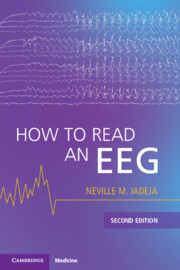Book contents
- How to Read an EEG
- Reviews
- How to Read an EEG
- Copyright page
- Dedication
- Contents
- Figure Contributions
- Foreword to the First Edition
- Preface
- How to Read This Book
- Part I Basics
- Chapter 1 Introduction
- Chapter 2 Polarity and Montages
- Chapter 3 Localization
- Chapter 4 Frequency and Rhythm
- Chapter 5 Maturation
- Chapter 6 Normal Adult EEG
- Part II Interpretation
- Part III Specific Conditions
- Appendix: How to Write a Report
- Index
- References
Chapter 2 - Polarity and Montages
from Part I - Basics
Published online by Cambridge University Press: aN Invalid Date NaN
- How to Read an EEG
- Reviews
- How to Read an EEG
- Copyright page
- Dedication
- Contents
- Figure Contributions
- Foreword to the First Edition
- Preface
- How to Read This Book
- Part I Basics
- Chapter 1 Introduction
- Chapter 2 Polarity and Montages
- Chapter 3 Localization
- Chapter 4 Frequency and Rhythm
- Chapter 5 Maturation
- Chapter 6 Normal Adult EEG
- Part II Interpretation
- Part III Specific Conditions
- Appendix: How to Write a Report
- Index
- References
Summary
This chapter discusses the concepts of polarity and montages including the implications of polarity, the types of montages, and how to use different montages during analysis. Polarity depends on the relative difference between two potentials with the pointer always deflecting toward the relatively smaller potential. Cerebral potentials thus generate electrographic waveforms on the screen. Montages are specific arrangements of channels (pair of recording electrodes), each allowing appreciation of the waveform from a specific point of view. Bipolar montages consist of channels with adjacent electrode pairs and referential montages consist of channels with nonadjacent pairs. Bipolar montages are less prone to artifact and useful to analyze focal potentials. Referential montages are somewhat more prone to artifact contamination and more useful to analyze broader potentials. In this chapter, readers will learn to use both types of montages for analysis. [137 words/830 characters]
Information
- Type
- Chapter
- Information
- How to Read an EEG , pp. 15 - 23Publisher: Cambridge University PressPrint publication year: 2025
References
Accessibility standard: WCAG 2.2 AAA
Content Navigation
Allows you to navigate directly to chapters, sections, or non‐text items through a linked table of contents, reducing the need for extensive scrolling.
Provides an interactive index, letting you go straight to where a term or subject appears in the text without manual searching.
Reading Order & Textual Equivalents
You will encounter all content (including footnotes, captions, etc.) in a clear, sequential flow, making it easier to follow with assistive tools like screen readers.
You get concise descriptions (for images, charts, or media clips), ensuring you do not miss crucial information when visual or audio elements are not accessible.
You get more than just short alt text: you have comprehensive text equivalents, transcripts, captions, or audio descriptions for substantial non‐text content, which is especially helpful for complex visuals or multimedia.
Visual Accessibility
You will still understand key ideas or prompts without relying solely on colour, which is especially helpful if you have colour vision deficiencies.
You benefit from high‐contrast text, which improves legibility if you have low vision or if you are reading in less‐than‐ideal lighting conditions.
